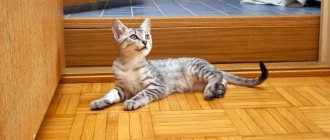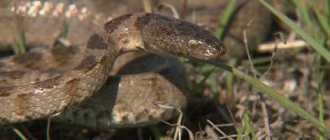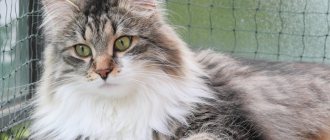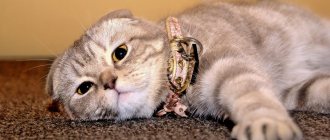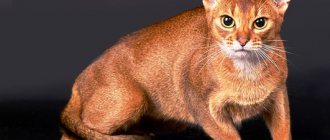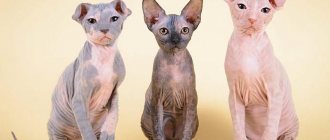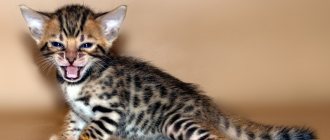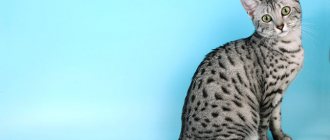The Egyptian Mau is the oldest breed, having been around for at least 3,000 years. Despite its almost complete extinction by the beginning of the twentieth century, now this breed is thriving and arousing the most lively interest.
In general, many breeds of cats were bred in Egypt, but this Egyptian Mau, thanks to its pretty appearance, unusual history of origin and unpretentiousness in everyday life, became the dream of all cat lovers in the world.
History of the Egyptian Mau breed
Egyptian Mau
The origin of the beauties goes back to the 6th-5th millennium BC. e. - the harsh era of the pharaohs, servile worship of the gods, trade in “living goods” and amazing unsanitary conditions. Egypt managed to become a rich and majestic country, despite the proximity of the desert and regular floods of the Nile River. The ruling dynasties bathed in luxury and honor. Commoners were forced to live with unfriendly fauna - rats, poisonous snakes and insects - which made an already difficult life even more burdensome.
Fortunately for the Egyptians, not all animals were hostile. African cats - the future ancestors of the Mau - often came to modest settlements, destroyed parasites and just as silently left. Over time, the unexpected alliance grew stronger. In gratitude for their help, the Egyptians rewarded cats with treats from their own food supplies and immortalized their noble appearance in art. Animals were allowed to enter the house, and soon they completely got used to the role of owners. This marked the beginning of the full domestication of African cats, which were used in hunting.
The first image of a domesticated cat found in a temple dates back to the 2nd millennium BC. e. At that time, animals played almost a central role in religion. The Egyptians believed that the main deity - the sun god Ra - turns into a cat, rising into the sky in the morning and descending underground in the evening, where Apophis, the god of chaos, awaits him every day, eager to engage in battle with his rival. Ancient drawings often depicted Ra in the guise of a huge spotted cat, tearing apart the enemy with sharp claws.
The connection between the four-legged beauties and the supreme god of the pantheon was also seen in their eyes. It was believed that the pupils of cats determine the position of the sun above the horizon: the wider they are, the lower the celestial body. In fact, changes in the size of the pupils are associated with their physiological characteristics, but in ancient times the incomprehensible nature of things was always explained by the intervention of higher powers.
From about the 1st millennium BC. e. cats were included in the cult of Bastet - the goddess of beauty, fertility and hearth. She was depicted as a woman with the head of a cat, sometimes in full animal form. Temple servants increasingly began to keep four-legged companions with them - the living embodiment of Bastet. Cats walked freely throughout the entire territory of the sanctuary, which was inaccessible to commoners. Forbidding animals to do anything was considered almost a mortal sin: they knew how to speak with the gods and protected those praying from dark forces. Amulets with their image brought the owner good luck in love.
Egyptian Mau bronze color
The sanctuary of Bastet - Bubastion - was visited by the Egyptians more often than others. Every day, believers handed over mummified cats to the priests, which were buried in separate rooms along with rodents and a vessel filled with milk. According to mythology, animals went to the afterlife, where they met Bastet and conveyed the requests of pilgrims to her.
An amazing legend is also associated with the ancestors of the Egyptian Mau, which emphasizes the importance of cats. Thus, the Persian king Cambyses from the Achaemenid dynasty won an easy victory over the Egyptians in 525 BC. e. thanks to these animals. On his orders, the soldiers caught the cats and tied them to their shields. The fear of the sacred companions of Bastet became the decisive factor: the townspeople laid down their arms because they did not want to harm the cats.
Despite their ancient origins, the history of the more modern descendants of the Egyptian Mau began in the 20th century, when European cat breeders decided to revive and breed a unique breed. The first mentions of that time date back to 1940, namely the publication in France of the memoirs “Our Cat Friends.” In them, Marcel Rene talked about spotted animals that he brought from Egypt. Unfortunately, the events of World War II significantly reduced the Mau population. The breed was on the verge of extinction and by the middle of the 20th century practically ceased to exist.
The repeated revival of the “Egyptian women” turned out to be successful, largely thanks to the activities of Natalia Trubetskoy. The Russian princess emigrated to Italy during the war, where in 1953 she first became acquainted with the magnificent spotted animals. They were presented as a gift by a Cairo man. Thus, Trubetskoy became the owner of Gregorio and Geppa of black and smoky colors, respectively, as well as the silver cat Lilu. In the same year, the first babies were born, which the princess immediately announced to representatives of the Italian branch of the International Cat Organization (FIFe).
In 1955, luxurious beauties appeared at a Roman exhibition, where they created a sensation. Three years later, Trubetskoy swapped sultry Italy for the unknown romance of the USA and took in several Mau - silver cats Baba and Lisa, as well as a bronze baby named Jojo. This is how the first Mau nursery, Fatima, appeared in America, where, under the leadership of Princess Trubetskoy, a team of breeders began breeding Egyptian beauties. At the same time, they decided to allow cats of smoky, bronze and silver colors to participate in exhibitions. Animals with black fur were kept exclusively for breeding. Natalia Trubetskaya was engaged in the selection of kittens that were as similar as possible to the ancient Egyptian cats from the frescoes.
All the wards of the Fatima nursery were conditionally united into the traditional Mau line. Subsequently, the breed was divided into two more branches - Indian and Egyptian. Cats brought from the respective countries participated in their creation. The appearance of individual Mau suggested that American Shorthair cats were also involved in the selection.
Official recognition of the breed by felinological organizations began in 1968, when representatives of the CFF approved the Mau standard. Other organizations also caught the Egyptian “fever”: CFA (1977), TICA (1988), FIFe (1992). The new breed from the Land of the Pharaohs was also recognized by the lesser-known ASC, ICU, and WCF. Stud book records of ancestry and pedigree were used to register each cat.
The Egyptian Mau returned to Europe in 1988. At the same time, on the initiative of Mau lovers, three official nurseries were created. Now representatives of the breed are found in Belgium, Italy, Great Britain, the Netherlands, Germany, France and Switzerland, although the number of breeders is still negligible. The lion's share of nurseries comes from America, which does not want to share its achievements in breeding Egyptian Mau. To acquire a smaller copy of an African predator is a rare success.
Appearance of the Egyptian Mau
Representatives of the breed are vaguely similar to Abyssinians, with the exception of their remarkable color.
Despite their origin, “Egyptians” do not look like typical oriental cats: their physique is more massive, but at the same time not devoid of graceful lines. The Egyptian Mau is a short-haired, medium-sized breed. The weight of animals varies depending on gender. The cats are slightly larger than their friends: their weight is 4.5-6 and 3-4.5 kg, respectively.
Head and skull
Egyptian Mau kitten
The animal's head looks like a small wedge with smooth outlines. There are no flat areas. The rounded forehead is marked with a characteristic point in the shape of the letter “M”. The contours of the skull are smoothed, there are no depressions or protrusions.
Muzzle
The muzzle of the Egyptian Mau “fits” into the lines of the head and is perfectly balanced. It is characterized by a rounded wedge shape. Full cheeks are acceptable only in mature cats. The cheekbones are quite high. The stop is a smooth curve without kinks. The cat's evenly wide nose is set at a slight angle to the forehead. There is a hump. The chin is small but strong. It is formed by medium-sized jaws. The latter can be pronounced in adult males.
Ears
Sleepy kingdom
The top of the cat's head is topped with medium and large "triangles" that continue the line of the head. The Egyptian Mau's ears have a wide base and are set with a slight tilt forward, quite far from the center line. The tips are pointed, “tassels” are welcome. The ears are covered with short hair.
Eyes
The slightly slanted eyes of the Egyptian Mau are distinguished by their wide set. The shape is an intermediate “stage” between round and almond-shaped. The iris is pigmented in a light shade of green. Amber eyes are typical only for representatives of the breed up to one and a half years old. Egyptian Mau have a surprised and funny look.
Neck
The cat's short neck is smoothly curved. Strong muscles can be felt under the skin - males are characterized by a more pronounced relief. On the line of the ears towards the back of the head, a “scarab” is visible - a mark in the shape of the Latin letter W.
Egyptian Mau face
Frame
Egyptian Mau are animals with an elongated and elegant body, which is not at all spoiled by a developed muscular system. At the same time, a well-balanced torso is preferable to large sizes (regardless of gender). Angled shoulders are more developed in cats than in female cats. The back is straight. The belly is “decorated” with a fold of skin, which, according to felinologists, makes the Mau’s movements easier and more flexible.
Tail
The Egyptian Mau's tail is of medium length, varying in width from the base to a dark cone-shaped tip.
Limbs
Egyptian Mau playing with a stick
The hind limbs of the Egyptian Mau are longer than the front ones. Despite this difference, the cat does not look slouched. The muscles and bones are strong, but mobile. The shape of the paws is round or oval. The toes on the hind legs are more elongated than on the front ones. Their number also varies: four and five, respectively.
Coat
The Mau's short coat lies close to the body. Despite its insignificant thickness, it perfectly protects its owner from bad weather. The texture of the coat mainly depends on the color of the animal. Silver and bronze beauties have a soft coat, while smoky ones are more silky and smooth.
Color
The Egyptian Mau standard provides for three color options.
- Silver - from a light color to a medium-saturated shade. The points contrast thanks to a dark gray or black tint. The rims of the eyes, lips and nose are pigmented black. The tips of the ears are dark. The neck, chin and area around the cat's nostrils are covered with white hair.
- Bronze - a dark shade transitions towards the belly into a lighter, almost milky shade. The markings on the body and the tips of the ears are dark brown. Cream color is characteristic of the fur on the throat, chin, and the area near the tip of the muzzle and around the eyes. The bridge of the nose is colored ocher.
- Smoky - from dark gray to almost black. The silvery undercoat is visible. The points contrast with the main color.
Hair ticking is inherent in the first two types of colors, but is completely absent in the third. The markings are predominantly circular in shape.
Possible defects
Graceful beauty
The main defects of the Egyptian Mau breed include:
- amber pigmentation of the iris in animals older than one and a half years;
- long hair with a thick undercoat (like the “British”);
- excessively small or large ears;
- marks merging with each other;
- full cheeks in females;
- short and/or pointed muzzle;
- small and/or round head;
- points on the body in the form of stripes;
- short and/or thin tail;
- no spots on the belly;
- undeveloped chin;
- small eye size.
Disqualifying defects include:
- lack of ticking in bronze and silver cats;
- white points and/or “medallion” on the chest;
- ticking in smoky-colored animals;
- wrong number of fingers;
- testicles not descended into the scrotum;
- atypical eye pigmentation;
- obvious bone deformations;
- complete absence of stains;
- amputated claws;
- deafness.
Photos of the Egyptian Mau
Character of the Egyptian Mau
The breed is famous not only for its spectacular beauty, but also for its cheerful disposition. These animals are wind-up toys that do not run on batteries, but at least with the help of a perpetual motion machine! The Egyptian Mau loves to take on different roles. In the mornings, the cat skillfully pretends to be an alarm clock, during the day it prefers to be a tireless fidget, and in the evening it becomes a purring antidepressant. With such a wonderful friend, every minute will become a bright holiday!
Egyptian Mau with Abyssinian cat
Representatives of the breed are distinguished by inexhaustible energy and a curious mind, which do not allow animals to sit in one place. Mau will certainly explore all the secret “passages” between the cabinets and the wall. Be prepared to fish your pet out of the most unexpected hiding places: this spotted fidget will crawl anywhere its curious face can fit. “Moveable” toys will help channel the energy of the Egyptian Mau into a peaceful channel: ropes with a bow at the end or wind-up mice. Having satisfied its hunting instinct, the cat will go on a well-deserved rest and give you a few minutes of peace.
Breeders note: this breed is one of the most loyal and loving. Egyptian Mau treat all family members with tenderness, but they consider one person to be the owner. It is to this lucky person that the cat is ready to give attention and love, but will never force it on him. The spotted beauty will happily bask in your arms, but will move away at the first request. When taking an “Egyptian” into your home, it is worth considering: this is a proud and self-sufficient animal, and not a weak-willed meowing lump.
The breed cannot be called talkative: Mau only speaks in exceptional cases (especially when it comes to delicacies). Cats rarely meow, prefer to communicate with their owner through purring and can boast of a whole palette of these sounds. During the period of the so-called sexual heat, females are especially loud. To avoid operatic lamentations, it is recommended to sterilize the capricious lady so that she does not demand dates with the spotted gentleman.
High five!
Egyptian Mau tolerate loneliness well and will not object to your advancement in your career. Sometimes a pet may get bored, but will not allow itself crazy antics such as continuous meowing under the door and grinding its claws on its favorite sofa. At these moments, the nobility of the ancient pharaohs is especially evident in the cat. Instead of silly games with its own tail, the Mau will jump onto the highest cabinet and sit proudly until you return.
The activity of animals is significantly dulled even after eating. This is necessarily followed by a healthy and sound sleep - an unchanging ritual that is observed by most representatives of the breed. At the same time, it is important to give the pet a rest: from boredom and lack of energy, the cat will begin to eat and sleep more often, which will ultimately make it a spotted and fairly plump “bun”.
The love for water is another unusual feature that distinguishes the “Egyptian women” from their mustachioed counterparts. This feeling manifests itself in different ways and depends on the character of the cat. Some animals will happily jump into a filled bath and rush in pursuit of drops, while others will limit themselves to a paw lowered into the water.
Egyptian Mau are quite friendly creatures, so it is not difficult for them to find a common language with other pets. A cat or a dog doesn’t matter, but keeping birds and rodents will have to wait. Wild African cats have endowed their descendants with a thirst for hunting, so the Mau can attack your little friend at any time.
This breed gets along well with families with children. It's hard to imagine a more playful friend! However, do not expect that the Egyptian Mau will allow your child liberties in the form of swaddling and bottle feeding. The cat will prefer to proudly retire if it decides that the child is unceremoniously invading its personal space.
The Egyptian Mau is a suitable option for those who need a balanced friend. Despite its playful nature, the animal always behaves with dignity and restraint, as if it still lives in the monastery of the pharaoh or serves as a “talisman” in an ancient Egyptian temple.
Egyptian Mau silver color
Attitude towards other animals
Relationships with animals develop differently. For example, if a dog like a shepherd or a diver lives in the house, then there probably won’t be any problems. The Egyptian Mau will easily get along with such a neighbor, perhaps they will even sleep and eat together. Miniature dogs that bark a lot are more likely to be looked down upon and ignored by the pet until they get in the way. Well, if necessary, he will give a worthy rebuff, leaving deep scratches on the nose of the annoying dog.
@christarenee22
Relations with representatives of your tribe are smooth, if this depends on the Egyptian Mau. If the neighbors are trying to demonstrate dominance or are otherwise aggressive, then in this case the native of the Nile Valley will try not to enter into conflict - instead, she will retire with dignity to a place where she will not be disturbed to rest.
@cats.toast.and.pris
But the Egyptian Mau does not have the best relationship with rodents, such as rats, mice and hamsters. The fact is that the cat perceives them as prey. After all, for thousands of years, cats of this breed were kept in Egypt in order to destroy pests. And this habit became an integral part of nature for the Mau. Therefore, if you have pet rodents in the house, take care of their safety and try not to leave them alone with the Egyptian Mau. Well, if a Mau already lives in the apartment, then it is better not to have rodents, so as not to expose them to unnecessary danger.
Education and training
Egyptian Mau on a leash
Representatives of the breed are distinguished by their unique intelligence and impeccable manners, so they rarely need additional training. Mau owners do not have any difficulties training their cats to use the litter tray and scratching post. Animals quickly understand what is expected of them. This greatly simplifies the training process. Egyptian Mau are observant and intelligent, easily overcome obstacles and quickly get used to walking on a leash. If desired, you can teach your pet simple commands: the cat will demonstrate their execution in exchange for a delicious treat.
Owner reviews
To form an objective opinion about the breed, it is useful to study reviews from owners who have significant experience in keeping Egyptian Mau.
Almost everyone notes a playful and peaceful character. External beauty and sophistication also leave no questions - it’s stupid to argue with that. Many people also like that caring for a cat is simple - much easier than most other purebred pets. If you start it in a private house, then the mice will quickly run out or they will prefer to stay away from such a dangerous place.
There aren't many disadvantages. One of them is a sociable nature, sometimes turning into obsessive. Wherever the owners go, the pet will follow them. And if you close the door in front of your nose, then she will not hesitate to let out a loud “mau”. Moreover, the cat has an excellent voice and can produce nasty, drawn-out roulades.
So, you should think seriously before getting such a pet.
Care and maintenance
Short-haired Egyptian Mau are not picky about their upkeep, but rest assured: you won’t have any remorse in leaving such a charming beauty untidy. These cats do a pretty good job of grooming their own coats, but brushing the fur with an Egyptian Mau brush or mitten won't hurt. This massage will not only give your pet a neat look, but will also strengthen the hair follicles.
The breed is famous for its cleanliness, so many Mau owners do without water treatments at all (with the exception of playing with mini-waves in the bath). However, before participating in the exhibition, it is recommended to bathe your pet with cat shampoo. For silver-colored Mau, you can choose a tonic that will make the color more saturated and rid the coat of yellowness. After taking a bath - and it can last for more than an hour due to the inexhaustible love of cats for water - eliminate the source of possible drafts so that the pet does not catch a cold.
Eye care for the Egyptian Mau is minimal. Due to their specific structure, they rarely tear, and there is practically no discharge in the corners. The animal’s ears will have to be given more attention: in particular, they should be inspected once a week and cleaned with a damp cotton pad as necessary.
Egyptian Mau drinks tap water
Oral hygiene is no less important. Once or twice a month, clean your cat's teeth from plaque using a paste (you can find it at a pet store). Use a brush or attachment; in extreme cases, a finger tightly wrapped in a bandage will do. From time to time you can please your pet with special treats, which, due to their hardness, carry out preventive teeth cleaning.
To create a neat “manicure” on the paws of the Egyptian Mau, use a nail clipper. After the procedure, it is necessary to smooth out sharp edges and jagged edges using a nail file. To do this as little as possible, teach your cat to use a scratching post. Otherwise it will become a piece of furniture.
Looking at the Egyptian Mau, it is difficult to imagine that this graceful body hides a small gourmet and glutton. Representatives of the breed love to eat delicious food, so they do not control the size of portions. This responsible mission lies with the owner, who must ensure that the pet moves actively, eats in moderation and remains just as graceful.
It is preferable to feed the animal with premium food - dry or canned. Ideally, you should pay attention to options designed specifically for the breed. Egyptian Mau often suffer from food allergies, so finding the right food can take months. If you are ready to often pamper your cat with home-cooked dishes, stock up on dietary meat, sea fish, offal, seasonal vegetables and fruits, as well as sources of calcium.
Remember: it is strictly forbidden to combine two feeding options - this is fraught with problems with the gastrointestinal tract.
The Egyptian Mau should not eat:
- fatty meat (pork or lamb);
- spices (even in small quantities);
- river fish in any form;
- vegetables with a spicy taste;
- dry dog food;
- legumes;
- tubular bones;
- milk;
- liver;
- mushrooms;
- nuts.
Since these cats are very active, it is necessary to provide them with access to clean and fresh water. Mau owners recommend using bottled water, noting the fastidiousness of the “Egyptian”. Animals have inherited from their wild ancestors an instinct with which they determine whether water is suitable for consumption. To do this, the cat puts its paw into the bowl and carefully tastes the liquid.
Playfulness
Playfulness is the middle name of the Egyptian Mau. She is always full of energy, loves to run, jump and frolic. Thanks to this, even in old age she remains muscular, graceful and agile. It is important to walk your cat at least a couple of times a week so that she can run around to her heart's content, and at the same time explore the world around her - this gives her incomparable pleasure.
You should definitely give your cat suitable toys - swingers, jingling balls and others. She will certainly spend a lot of time with her favorite toys, satisfying her natural craving for hunting. And you will have to devote less time to her and you can calmly go about your business.
Health of the Egyptian Mau
Kittens are resting
Spotted Cleopatras have strong immunity, so they rarely suffer from common “animal” ailments. In the middle of the 20th century, when the breed was just entering the international arena, its representatives suffered from asthma and cardiovascular diseases. However, breeders have worked hard to keep these occurrences to a minimum with each new litter. Diseases are now quite rare, but the vulnerability of the Egyptian Mau's respiratory system has not disappeared. It is strongly recommended to protect your pet from smoke, dust and strong odors.
The main scourge of the breed remains allergies. If red spots appear on your cat's body, you need to change its diet as soon as possible and consult a veterinarian for advice.
Diseases of Egyptian women
Initially, the gene pool of the breed was very limited. It is therefore not surprising that the Egyptian Mau were susceptible to a wide range of genetic diseases. The most common problems were heart (cardiomyopathy) and breathing (asthma). However, thanks to the efforts of felinologists, the breed has become healthier.
Today, Egyptian cats delight their owners and live an average of 14 years.
The Mau owner should take into account that the pet still has a predisposition to allergies to certain types of food and a sensitive respiratory system - the cat must be protected from dust and smoke.
Conclusions about the Egyptian cat breed
global $ads_google;
//data-ad-slot=”2475549904″ $ads_google = empty($ads_google) ? false : true; ?> if ($ads_google == false) {?> $ads_google = true; ?> } ?> So, if you are still unsure whether you want to get another spotted four-legged family member from Egypt, here is a summary for you:
- Egyptian Mau are status animals with a luxurious coat and a regal gait. Of course, buying a cat from a cattery and maintaining it is financially very expensive. However, for 12-15 years he will delight the owner with his charismatic cat persona.
- Animals of this breed are not proud and are very playful. They get along well with other animals and children. But due to the clearly manifested qualities of a hunter, cats are not friends with rodents and birds.
In principle, Egyptian Mau are healthy animals that require standard care. If you approach his upbringing responsibly, keeping a cat will not cause much trouble.
How to choose a kitten
Despite active work on breeding Egyptian Mau, purebred individuals are extremely rare and only in specialized nurseries. Have you met a spotted beauty for sale? Don’t rush to rejoice: probably, under the characteristic color there is an ordinary “Murzik” hiding, for which they want to get a lot of money.
If you are applying for a bright representative of the breed, find an official Egyptian Mau nursery and do not forget to sign up for the kittens from the future litter. While waiting for your friend to be born, do not waste time: make inquiries about the breeder, if possible, contact his former clients, check out the achievements of the wards from this nursery. Often, breeders offer babies from related matings for sale, so you need to familiarize yourself with the complete pedigree of the kittens.
Little lumps are separated from their mother at the age of three months, when they no longer need care and can fend for themselves. When looking closely at the kittens, pay attention to the most playful and active one: he definitely feels great! The baby should be moderately well-fed and tidy. Sticky fur, sour eyes or accumulation of wax in the ears are reasons to think: is it worth buying a kitten if it is unhealthy?
Pay attention to a feature that is unique to the Egyptian Mau. At two months, kittens experience the appearance of fuzzing - sparse and long hairs that make babies look like porcupines. This is not a breed defect, but only one of the stages in the formation of the coat.
Feeding the cat
The Egyptian Mau can be given both commercial and natural food. When feeding dry food to a cat, premium or super-premium products are selected, which do not contain dyes, preservatives or other dubious additives.
The following brands of food best fit these criteria:
- Pronature;
- Hills;
- Brit Care;
- Gemon.
With the natural type of feeding, the Egyptian Mau is given predominantly lean, fresh meat. Also included in the cat’s diet:
- boiled vegetables;
- porridge with water;
- offal;
- eggs;
- dairy products;
- lean sea fish.
Egyptian cats should not be fed sausages, bones, sweets, baked goods or mushrooms. Also, representatives of the breed are prohibited from giving river fish, pickles, smoked meats and any food from the master’s table.
Photos of Egyptian Mau kittens
How much is the Egyptian Mau worth?
The Egyptian Mau breed is one of the rarest and most expensive. The price of a cat starts from 50 thousand rubles. The more the animal meets the standard, the higher the cost. You can “save” only on black Egyptian Mau. Since the characteristic spots merge with the main color of the coat, such specimens are considered rejected and are not allowed for breeding work or participation in exhibitions. However, if you are looking for a loyal and cheerful friend, the special color should not be an obstacle to acquiring an Egyptian Mau.
Application
What use can a cat have other than being a pet? But the Egyptian Mau can boast of hunter skills.
Thanks to its excellent eyesight and hearing, the animal, like the bobtail-Kuril cat , deftly hunts for small rodents.
In addition, this breed is a real running champion among cats. There is no other breed that can reach speeds of up to 58 km/h.
The Egyptian Mau is a true running champion among cats. There is no other breed that can reach speeds of up to 58 km/h
